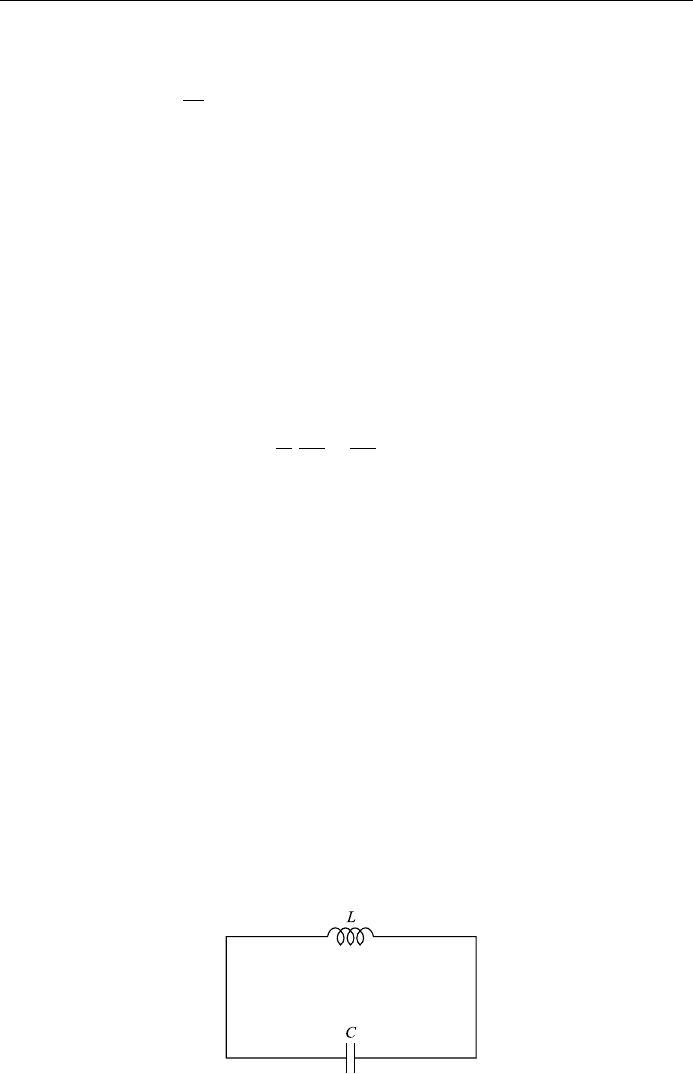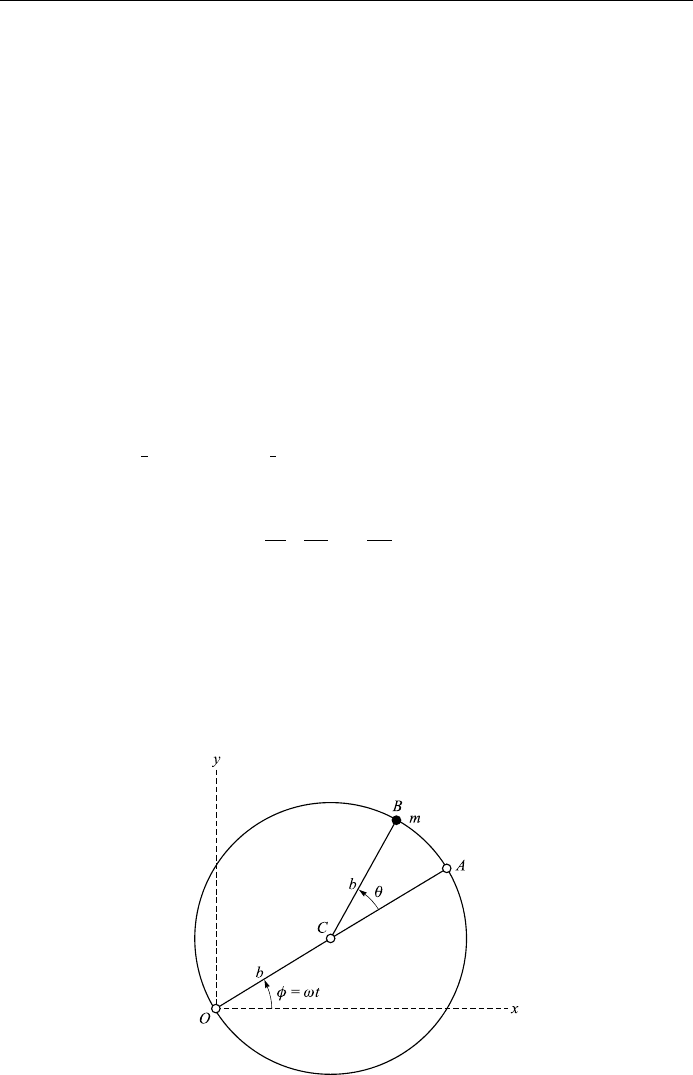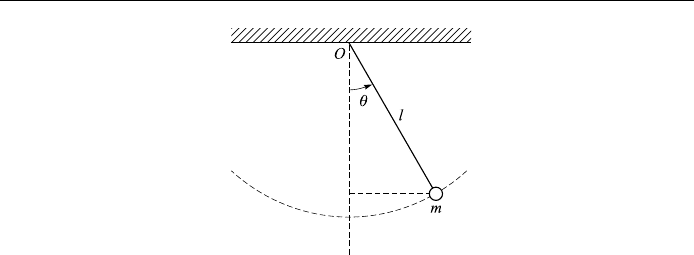Chow T.L. Mathematical Methods for Physicists: A Concise Introduction
Подождите немного. Документ загружается.


and Eq. (8.4) becomes
I
@I
@"
ý
ý
ý
ý
"0
d"
Z
t
2
t
1
Lq
i
t;
_
q
i
t; tdt 0; 8:18
where q
i
t, and hence
_
q
i
t, is to be varied subject to q
i
t
1
q
i
t
2
0.
Equation (8.18) is a mathematical statement of Hamilton's principle of classical
mechanics. In this variational approach to mechanics, the Lagrangian L is given,
and q
i
t taken on the prescribed values at t
1
and t
2
, but may be arbitrarily varied
for values of t between t
1
and t
2
.
In words, Hamilton's principle states that for a conservative dynamical system,
the motion of the system from its position in con®guration space at time t
1
to its
position at time t
2
follows a path for which the action integral (8.17) has a
stationary value. The resulting Euler±Lagrange equations are known as the
Lagrange equations of motion:
d
dt
@L
@
_
q
i
ÿ
@L
@q
i
0: 8:19
These Lagrange equations can be derived from Newton's equations of motion
(that is, the second law written in diÿerential equation form) and Newton's equa-
tions can be derived from Lagrange's equations. Thus they are `equivalent.'
However, Hamilton's principle can be applied to a wide range of phy sical phe-
nomena, particularly those involving ®elds, with which Newton's equations are
not usually associated. Therefore, Hamilton's principle is considered to be more
fundamental than Newton's equations and is often introduced as a basic postulate
from which various formulations of classical dynamics are derived.
Example 8.3
Electric oscillations: As an illustration of the generality of Lagrangian dynamics,
we consider its application to an LC circuit (inductive±capacitive circuit) as shown
in Fig. 8.4. At some instant of time the charge on the capacitor C is Qt and the
current ¯owing through the inductor is It
_
Qt. The voltage drop around the
356
THE CALCULUS OF VARIATIONS
Figure 8.4. LC circuit.

circuit is, according to Kirchhoÿ 's law
L
dI
dt
1
C
Z
Itdt 0
or in terms of Q
L
Q
1
C
Q 0:
This equation is of exactly the same form as that for a simple mechanical oscil-
lator:
m
x kx 0:
If the electric circuit also contains a resistor R, Kirchhoÿ 's law then gives
L
Q R
_
Q
1
C
Q 0;
which is of exactl y the same form as that for a damped oscillator
m
x b
_
x kx 0;
where b is the damping constant.
By comparing the corresponding terms in these equations, an analogy between
mechanical and electric quantities can be established:
x displacement Q charge (generalized coordinate)
_
x velocity
_
Q I electric current
m mass L inductance
1=kk spring constant C capacitance
b damping constant R electric resistance
1
2
m
_
x
2
kinetic energy
1
2
L
_
Q
2
energy stored in inductance
1
2
mx
2
potential energy
1
2
Q
2
=C e nergy stored in capacitance
If we recognize in the beginning that the charge Q in the circuit plays the role of a
generalized coordinate, and T
1
2
L
_
Q
2
and V
1
2
Q
2
=C, then the Langrangian L
of the system is
L T ÿ V
1
2
L
_
Q
2
ÿ
1
2
Q
2
=C
and the Lagrange equation gives
L
Q
1
C
Q 0;
the same equation as given by Kirchhoÿ 's law.
357
HAMILTON'S PRINCIPLE

Example 8.4
A bead of mass m slides freely on a frictionless wire of radius b that rotates in a
horizontal plane about a point on the circular wire with a constant angular
velocity !. Show that the bead oscillates as a pendulum of length l g=!
2
.
Solution: The circular wire rotates in the xy plane about the point O, as shown
in Fig. 8.5. The rotation is in the counterclockwise direction, C is the center of the
circular wi re, and the angles and are as indicated. The wire rotates with an
angular velocity !,so !t. Now the coordinates x and y of the bead are given
by
x b cos !t b cos !t;
y b sin !t b sin !t;
and the generalized coordinat e is . The potential energy of the bead (in a hor-
izontal plane) can be taken to be zero, while its kinetic energy is
T
1
2
m
_
x
2
_
y
2
1
2
mb
2
!
2
_
!
2
2!
_
!cos ;
which is also the Lagrangian of the bead. Inserting this into Lagrange's equation
d
d
@L
@
_
ÿ
@L
@
0
we obtain, after some simpli®cations ,
!
2
sin 0:
Comparing this equation with Lagrange's equation for a simple pendulum of
length l
g=lsin 0
358
THE CALCULUS OF VARIATIONS
Figure 8.5.

(Fig. 8.6) we see that the bead oscillates about the line OA like a pendulum of
length l g=!
2
.
Rayleigh±Ritz method
Hamilton's principle views the motion of a dynamical system as a whole and
involves a search for the path in con®guration space that yiel ds a stationary
value for the action integral (8.17):
I
Z
t
2
t
1
Lq
i
t;
_
q
i
t; tdt 0; 8:18
with q
i
t
1
q
i
t
2
0. Ordinarily it is used as a variational method to obtain
Lagrange's and Hamilton's equations of motion, so we do not often think of it as
a computational too l. But in other areas of physics variational formulations
are used in a much more active way. For example, the variational method for
determining the approximate ground-state energies in quantum mechani cs is
very well known. We now use the Rayleigh±Ritz method to illustrate that
Hamilton's principle can be used as computational device in classical
mechanics. The Rayleigh±Ritz method is a procedure for obtaining approximate
solutions of problems expressed in variational form directly from the variational
equation.
The Lagrangian is a functi on of the generalized coordinates qs and their time
derivatives
_
qs. The basic idea of the approximation method is to guess a solution
for the qs that depends on time and a number of parameters. The parameters are
then adjusted so that Hamilton's principle is satis®ed. The Rayleigh±Ritz method
takes a special form for the trial solution. A complete set of functions ff
i
tg is
chosen and the solution is assumed to be a linear combination of a ®nite number
of these functions. The coecients in this linear combination are the parameters
that are chosen to satisfy Hamilton's principle (8.18). Since the variations of the qs
359
RAYLEIGH±RITZ METHOD
Figure 8.6.

must vanish at the endpoints of the integral, the variations of the parameter must
be so chosen that this condition is satis®ed.
To summarize, suppose a given system can be described by the action integral
I
Z
t
2
t
1
Lq
i
t;
_
q
i
t; tdt;
_
q dq=dt:
The Rayleigh±Ritz method requires the selection of a trial solution, ideally in the
form
q
X
n
i1
a
i
f
i
t; 8:20
which satis®es the appropriate conditions at both the initial and ®nal times, and
where as are undetermined constant coecients and the fs are arbitrarily chosen
functions. This trial solution is substituted into the action integral I and integra-
tion is performed so that we obtain an express ion for the integral I in terms of the
coecients. The integral I is then made `stationary' with respect to the assumed
solution by requiring that
@I
@a
i
0 8:21
after which the resulting set of n simultaneous equations is solved for the values of
the coecients a
i
. To illustrate this method, we apply it to two simple examples.
Example 8.5
A simp le harmonic oscillator consists of a mass M attached to a spring of force
constant k. As a trial function we take the displacement x as a function t in the
form
xt
X
1
n1
A
n
sin n!t:
For the boundary conditions we have x 0; t 0, and x 0; t 2=!. Then the
potential energy and the kinetic energy are given by, respectively,
V
1
2
kx
2
1
2
k
P
1
n1
P
1
m1
A
n
A
m
sin n!t sin m!t;
T
1
2
M
_
x
2
1
2
M!
2
P
1
n1
P
1
m1
A
n
A
m
nm cos n!t cos m!t:
The action I has the form
I
Z
2=!
0
Ldt
Z
2=!
0
TÿVdt
2!
X
1
n1
kA
2
n
ÿ Mn
2
A
2
n
!
2
:
360
THE CALCULUS OF VARIATIONS

In order to satisfy Hamilton's principle we must choose the values of A
n
so as to
make I an extremum:
dI
dA
n
k ÿ n
2
!
2
MA
n
0:
The solution that meets the physics of the problem is
A
1
0;!
2
k=M; or 2=!
1=2
2 M= k
1=2
;
A
n
0; for n 2; 3; etc:
Example 8.6
As a second example, we consider a bead of mass M sliding freely along a wire
shaped in the form of a parabola along the vertical axis and of the form y ax
2
.
In this case, we have
L T ÿ V
1
2
M
_
x
2
_
y
2
ÿMgy
1
2
M1 4a
2
x
2
_
x
2
ÿ Mgy:
We assume
x A sin !t
to be an approximate value for the displacement x, and then the action integral
becomes
I
Z
2=!
0
Ldt
Z
2=!
0
T ÿ Vdt A
2
!
2
1 a
2
A
2
2
ÿ ga
()
M
!
:
The extremum condition, dI=dA 0, gives an approximate !:
!
2ga
p
1 a
2
A
2
;
and the approximate period is
21 a
2
A
2
2ga
p
:
The Rayleigh±Ritz method discussed in this section is a special case of the
general Rayleigh±Rit z methods that are designed for ®nding approximate solu-
tions of boundary-value problems by use of varitional principles, for example, the
eigenvalues and eigenfunctions of the Sturm±Liouville systems.
Hamilton's principle and canonical equations of motion
Newton ®rst form ulated classical mechanics in the seventeenth century and it is
known as Newtonian mechanics. The essential physics involved in Newtonian
361
HAMILTON'S PRINCIPLE

mechanics is contained in Newton's three laws of motion, with the second law
serving as the equation of motion. Classical mechanics has since been reformu-
lated in a few diÿerent forms: the Lagrange, the Hamilton, and the Hamilton±
Jacobi formalisms, to name just a few.
The essential physics of Lagrangian dynamics is contained in the Lagrange
function L of the dynamical system and Lagrange's equations (the equations of
motion). The Lagrangi an L is de®ned in terms of independent generalized coor-
dinates q
i
and the corresponding generalized velocity
_
q
i
. In Hamiltonian
dynamics, we describe the state of a system by Hamilton's function (or the
Hamiltonian) H de®ned in terms of the generalized coordinates q
i
and the corre-
sponding generalized momenta p
i
, and the equations of motion are given by
Hamilton's equations or canonical equations
_
q
i
@H
@p
i
;
_
p
i
ÿ
@H
@q
i
; i 1; 2; ...; n: 8:22
Hamilton's equations of motion can be derived from Hamilton's principle.
Before doing so, we have to de®ne the generalized momentum and the
Hamiltonian. The generalized momentum p
i
corresponding to q
i
is de®ned as
p
i
@L
@q
i
8:23
and the Hamiltonian of the system is de®ned by
H
X
i
p
i
_
q
i
ÿ L: 8:24
Even though
_
q
i
explicitly app ears in the de®ning expression (8.24), H is a function
of the generalized coordinates q
i
, the generalized momenta p
i
, and the time t,
because the de®ning expression (8.23) can be solved explicitly for the
_
q
i
sin
terms of p
i
; q
i
, and t. The qsandps are now treated the same: H Hq
i
; p
i
; t.
Just as with the con®guration space spanned by the n independent qs, we can
imagine a space of 2n dimensions spanned by the 2n variables
q
1
; q
2
; ...; q
n
; p
1
; p
2
; ...; p
n
. Such a space is called phase space, and is particularly
useful in both statistical mechanics and the study of non-linear oscillations. The
evolution of a representative point in this space is determined by Hamilton's
equations.
We are ready to deduce Hamilton's equation from Hamilton's principle. The
original Hamilton's principle refers to paths in con®guration space, so in order to
extend the principle to phase space, we must modify it such that the integrand of
the action I is a function of both the generalized coordinates and momenta and
their derivatives. The action I can then be evaluated over the paths of the syst em
362
THE CALCULUS OF VARIATIONS

point in phase space. To do this, ®rst we solve Eq. (8.24) for L
L
X
i
p
i
_
q
i
ÿ H
and then substitute L into Eq. (8.18) and we obtain
I
Z
t
2
t
1
X
i
p
i
_
q
i
ÿ Hp; q; t
dt 0; 8:25
where q
I
t is still varied subject to q
i
t
1
q
i
t
2
0, but p
i
is varied without
such end-point restrictions.
Carrying out the variation, we obtain
Z
t
2
t
1
X
i
p
i
_
q
i
_
q
i
p
i
ÿ
@H
@q
i
q
i
ÿ
@H
@p
i
p
i
dt 0; 8:26
where the
_
qs are related to the qs by the relation
_
q
i
d
dt
q
i
: 8:27
Now we integrate the term p
i
_
q
i
dt by parts. Using Eq. (8.27) and the endpoint
conditions on q
i
, we ®nd that
Z
t
2
t
1
X
i
p
i
_
q
i
dt
Z
t
2
t
1
X
i
p
i
d
dt
q
i
dt
Z
t
2
t
1
X
i
d
dt
p
i
q
i
dt ÿ
Z
t
2
t
1
X
i
_
p
i
q
i
dt
p
i
q
i
ý
ý
ý
ý
t
2
t
1
ÿ
Z
t
2
t
1
X
i
_
p
i
q
i
dt
ÿ
Z
t
2
t
1
X
i
_
p
i
q
i
dt:
Substituting this back into Eq. (8.26), we obtain
Z
t
2
t
1
X
i
_
q
i
ÿ
@H
@p
i
p
i
ÿ
_
p
i
@H
@q
i
q
i
dt 0: 8:28
Since we view Hamilton's principle as a variational principle in phase space, both
the qs and the ps are arbitrary, the coecients of q
i
and p
i
in Eq. (8.28) must
vanish separately, which results in the 2n Hamilton's equations (8.22).
Example 8.7
Obtain Hamilton's equations of motion for a one-dimensional harmonic oscilla-
tor.
363
HAMILTON'S PRINCIPLE

Solution: We have
T
1
2
m
_
x
2
; V
1
2
Kx
2
;
p
@L
@
_
x
@T
@
_
x
m
_
x;
_
x
p
m
:
Hence
H p
_
x ÿ L T V
1
2m
p
2
1
2
Kx
2
:
Hamilton's equations
_
x
@H
@p
;
_
p ÿ
@H
@x
then read
_
x
p
m
;
_
p ÿKx:
Using the ®rst equation, the second can be written
d
dt
m
_
xÿKx or m
x Kx 0
which is the familiar equation of the harmonic oscillator.
The modi®ed Hamilton's principle and the Hamilton±Jacobi equation
The Hamilton±Jacobi equation is the cornerstone of a general method of integrat-
ing equations of motion. Before the advent of modern quantum theory, Bohr's
atomic theory was treated in terms of Hamilton±Jacobi theory. It also plays an
important role in optics as well as in canonical perturbation theory. In classical
mechanics books, the Hamilton±Jacobi equation is often obtained via canonical
transformations. We want to show that the Hamilton±Jacobi equation can also be
obtained directly from Hamilton's principle, or , a modi®ed Hamilton's principle.
In formulating Hamilton's principle, we have considered the action
I
Z
t
2
t
1
Lq
i
t;
_
q
i
t; tdt;
_
q dq=dt;
taken along a path between two given positions q
i
t
1
and q
i
t
2
which the dyna-
mical system occupies at given instants t
1
and t
2
. In varying the action, we com-
pare the values of the action for neighboring paths with ®xed ends, that is, with
q
i
t
1
q
i
t
2
0. Only one of these paths corresponds to the true dynamical
path for which the action has its extremum value.
We now consider another aspect of the concept of action, by regarding I as a
quantity characterizing the motion along the true path, and comparing the value
364
THE CALCULUS OF VARIATIONS

of I for paths having a common beginning at q
i
t
1
, but passing through diÿerent
points at time t
2
. In other words we consider the action I for the true path as a
function of the coordinates at the upper limit of integration:
I Iq
i
; t;
where q
i
are the coordinates of the ®nal position of the system, and t is the instant
when this position is reached.
If q
i
t
2
are the coordinates of the ®nal position of the system reached at time t
2
,
the coordinates of a point near the point q
i
t
2
can be written as q
i
t
1
q
i
,
where q
i
is a small quantity. The action for the trajectory bringing the system
to the point q
i
t
1
q
i
diÿers from the action for the trajectory bringing the
system to the point q
i
t
2
by the quantity
I
Z
t
2
t
1
@L
@q
i
q
i
@L
@
_
q
i
_
q
i
dt; 8:29
where q
i
is the diÿerence between the values of q
i
taken for both paths at the same
instant t; similarly,
_
q
i
is the diÿerence between the values of
_
q
i
at the instant t.
We now integrate the second term on the right hand side of Eq. (8.25) by parts:
Z
t
2
t
1
@L
@
_
q
i
_
q
i
dt
@L
@
_
q
i
q
i
ÿ
Z
t
2
t
1
d
dt
@L
@
_
q
i
q
i
dt
p
i
q
i
ÿ
Z
t
2
t
1
d
dt
@L
@
_
q
i
q
i
dt; 8:30
where we have used the fact that the starting points of both paths coincide, hence
q
i
t
1
0; the quantity q
i
t
2
is now written as just q
i
. Substituting Eq. (8.30)
into Eq. (8.29), we obtain
I
X
i
p
i
q
i
Z
t
2
t
1
X
i
@L
@q
i
ÿ
d
dt
@L
@
_
q
i
q
i
dt: 8:31
Since the true path satis®es Lagrange's equations of motion, the integrand and,
consequently, the integral itself vanish. We have thus obtained the following value
for the increment of the action I due to the change in the coordinates of the ®nal
position of the system by q
i
(at a constant time of motion):
I
X
i
p
i
q
i
; 8:32
from which it follows that
@I
@q
i
p
i
; 8:33
that is, the partial derivatives of the action with respect to the generalized co-
ordinates equal the corresponding generalized momenta.
365
THE MODIFIED HAMILTON'S PRINCIPLE
